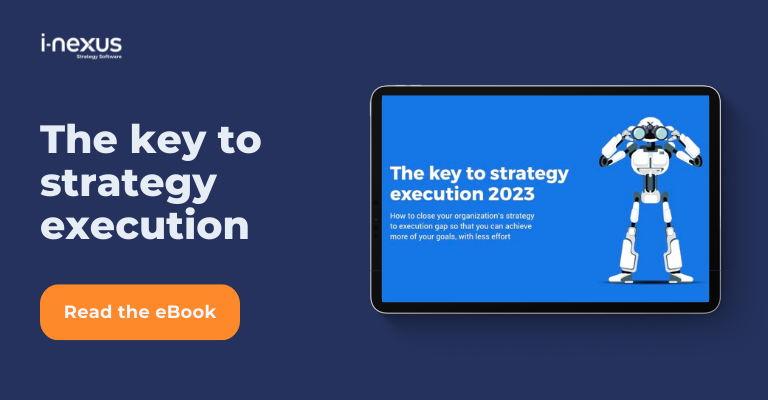While much has been said about the failures in Strategy Execution Management, what can be written around its value and, more importantly, what can be said beyond it being a vehicle for greater ROI? Here are 5 ways you can look at the value of Strategy Execution Management by moving beyond ROI.
Written by: James Milsom, Head of Marketing
As commercial leaders, we default to monetary value as a metric of success on the projects we run.
After all, if the activity does not lead to an increase which can be measured by revenue or reduced expenditure, how can we know that it has indeed had a positive outcome?
The realm of business transformation seeks to identify and put into action initiatives that can help your organization to see breakthrough changes in its performance, naturally meaning more revenue.
However, is the ROI the only metric of your efforts? Or, perhaps we consider looking outside of what we consider our comfort zone and consider value as to be monetary, tangible and intangible?
From a sense of belonging through to transformative processes being translated to business as usual and shortcomings feeding success, these are five different ways you can report to your stakeholders the value of your Strategy Execution Management efforts.
1. You're driving employee morale
What better place to prove the value of your transformative efforts than with employee morale.
And how do you measure commitment? Employee churn rates and time in post.
These two metrics will help you to truly understand the happiness and fulfillment that an employee, in fact, your entire organization, has from your strategic portfolio and the direction that you have set them on with your strategy.
When we turn to surveys and reports into the matter of employee retention, Vantage Circle’s 2020 overview provides interesting reading:
- 78% of employees would remain longer at their employer if they saw a clear career path in the company
- 83% of businesses see retaining talent as a growing challenge
These statistics are grim reading for organizations who have not thoroughly thought through the importance of their culture, as well as utilizing strategic projects as an opportunity to provide development paths within their business for those with an appetite to progress.
Strategy Execution Management revolves around employee engagement and motivation.
By using different engagement techniques such as catchball you can involve your team in playing an important role in forming the annual goals and projects to support your breakthrough objectives.
You should keep the momentum rolling by using open communication and transparency as a policy.
This honesty will be rewarded with motivated team members and, as IBM has proven, 80% of employees feel more engaged when their work is aligned to core values and your organization's mission – this will be natural as your business policy and strategy will be in unison.
2. A sense of belonging
In 2019, Harvard Business Review reported a strong tie between belonging and ROI in business:
“If workers feel like they belong, companies reap substantial bottom-line benefits. High belonging was linked to a whopping 56% increase in job performance, a 50% drop in turnover risk, and a 75% reduction in sick days.”
By adopting a framework such as OKR or Hoshin Kanri, you are naturally introducer order and parity of how you are executing and measuring projects and their performance.
Much like Continuous Improvement is well placed to amplify the employee’s voice in short-term efforts, a sense of belonging is achieved by utilizing dashboards and Strategy Execution Management software and solutions to ensure all activity is tracked and contributing to the strategic success.
For example, this could be achieved through a mobile application that supports journals and metric entry by front-line staff, which, when deployed to all team members, will give parity of treatment and foster a sense that every employee has a place in strategic delivery.
i-nexus’ Pulse does just this – it empowers users to consistently execute project updates, ensuring action and measurement in real-time, re-focusing the conversation from process to outcome.
To learn more about how i-nexus Pulse can drive employee engagement in your Strategy Execution, register your interest in a one-to-one overview session.
Click here to register your interest in i-nexus Pulse
3. Limiting water cooler talk rumors
Prior to COVID-19, plenty of conversations took place at the water coolers or in your office’s kitchen about rumors and innuendo which, whether good or bad, kept your team engaged.
However, the Economist Intelligence Unit’s 2019 study into the impact of workplace communication drives home the challenge that many organizations face with the water cooler, be that in the office or over Zoom:
“Employees believe miscommunication is contributing to their stress, failure to complete projects and loss of sales.
Employees’ struggles to connect often result in unclear expectations that are amplified under pressure.”
A clear benefit of Strategy Execution Management is the transparency and direction setting involved with following processes such as the seven steps of Hoshin Kanri.
These well-formed processes ensure that your staff is aware of the exact targets and projects they are expected to be involved in to support the achievement of breakthrough goals.
Furthermore, the use of action plans and targets to improve dashboards only serves to reinforce the expectations that are set of your team, all the while providing clear communication of direction and purpose to the entire organization.
This, when combined with roadshows and a suite of communication tools, only serve to demonstrate the direction your organization continues to head in and dispel demoralizing rumors about the state of the nation.
4. Better serving customers
The ultimate goal of Strategy Execution Management is not ROI. It rests in the hearts and minds of your customers.
Why do we seek to achieve breakthrough levels of performance? Is it solely for shareholder profits? Or, do we need to consider that it is our customers who provide a present and future for our business?
One would argue that it is firmly the latter.
The voice of the customer should be the heartbeat of your organization.
Your breakthrough goals exist to better serve your customers.
As Forbes reported:
“84% of companies that work to improve their customer experience report an increase in their revenue.”
Customer satisfaction is often reflected in higher retention rates and more profit per individual, but it can go beyond these traditional measurements.
For example, if your customers are left unsatisfied by the delivery part of your supply chain and an improvement priority is to implement an entirely new supplier and process for delivery, you would look towards surveying your customers impacted by the new process to gauge your efforts.
Whatever it is that your customer base has told you they desire, this will help you to understand the value of your Strategy Execution Management.
Indeed, delivering projects on time and under budget is important to track within your strategy platform, but they do very little to show you the overall value of your efforts.
In fact, by valuing the ROI of the resource and effort placed in this improvement priority above all else you can do a disservice to the efficacy of your Strategy Execution.
5. Shortcomings feed success
The final example of the value in Strategy Execution Management is counting your failures.
Indeed, in very limited cases can you determine value from a shortcoming, but with Strategy Execution Management this proves the exception to the rule.
Built into any strategic framework are countermeasures.
Countermeasures turn your shortcomings into successes. By running root causes analyses, adopting techniques such as the 5 Whys, and transforming this into action plans for corrective actions, you are gaining value from the Strategy Execution process.
Without adopting a well-planned view of your breakthrough goals, annual objectives, improvement priorities, and accompanying actions, you are unable to learn from your failures in an industrialized manner.
Add to this the adoption of software to form an archive of these lessons for replication across the entire business, you begin to take a more wholesome view of how your efforts can always bring you one step closer to realizing your goals.
However, this is dependent on having the correct leadership traits in your management team, as without leaders who embrace shortcomings, and in fact, hide these due to poor traits, the value that exists in your efforts will never be realized, regardless of the outcome.
Your efforts must be communicated
The conclusion of this blog leads to one path – communication is central to Strategy Execution Management.
Indeed, communication of your plan, rewards for employees, ownership, and metrics of success, all the while embracing your failings, are the ingredients to presenting the value of your Strategy Execution Management.
It would be short-sighted to believe that your organization should measure its strategic success solely by ROI.
Employee retention, happiness, and engagement in your strategy are wonderful signs of the success of your strategic management. How your customers feel and react to your changes are, in addition, beautiful illustrations of the impact of your efforts.
And, after all, should our businesses not be judged on the impact we bring to the people who create and consume our products and services?
Moving forward with Strategy Execution Management
Strategy Execution Management has many ways of being deemed valuable, however, there remains a plethora of challenges and knowledge to consume to master Strategy Execution.
To continue your journey, click here to visit our Strategy Execution Management knowledge hub, filled with content to support you in embracing the 'no normal' of strategy in the 2020s and beyond, or explore these recommendations:
- Hoshin Kanri strategic planning template set: Plan, execute, and track your Hoshin with this Excel pack.
- How AI and machine-assisted learning will help your Strategy Execution: As Artificial Intelligence becomes a mainstay in our lives, read how AI and machine-assisted learning will evolve to support your Strategy Execution.
- Download our Key to Strategy Execution eBook: Read how companies like Danaher and HP have mastered Strategy Execution Management and what you can learn from them.
About the author
James Milsom is Head of Marketing at i-nexus. James has wide-ranging experience in markets such as telecommunications, energy, education, and software.
As Head of Marketing, his drive is to raise awareness and understanding of the challenges facing enterprises in delivering strategic objectives and transformation amidst changing markets and the obstacles traditional tools and methods present leaders.
If you’d like to talk more about Strategy Execution, reach out to James on james.milsom@i-nexus.com or connect with him on LinkedIn for the latest insights.




